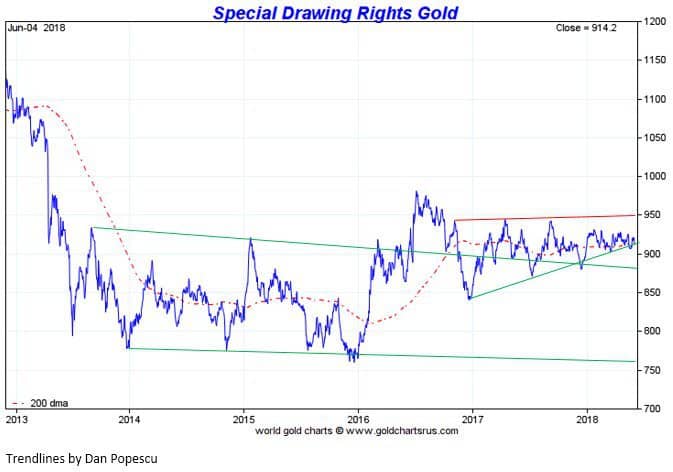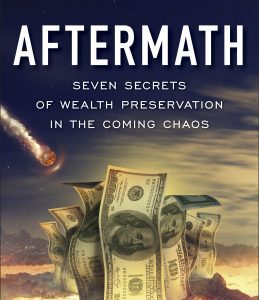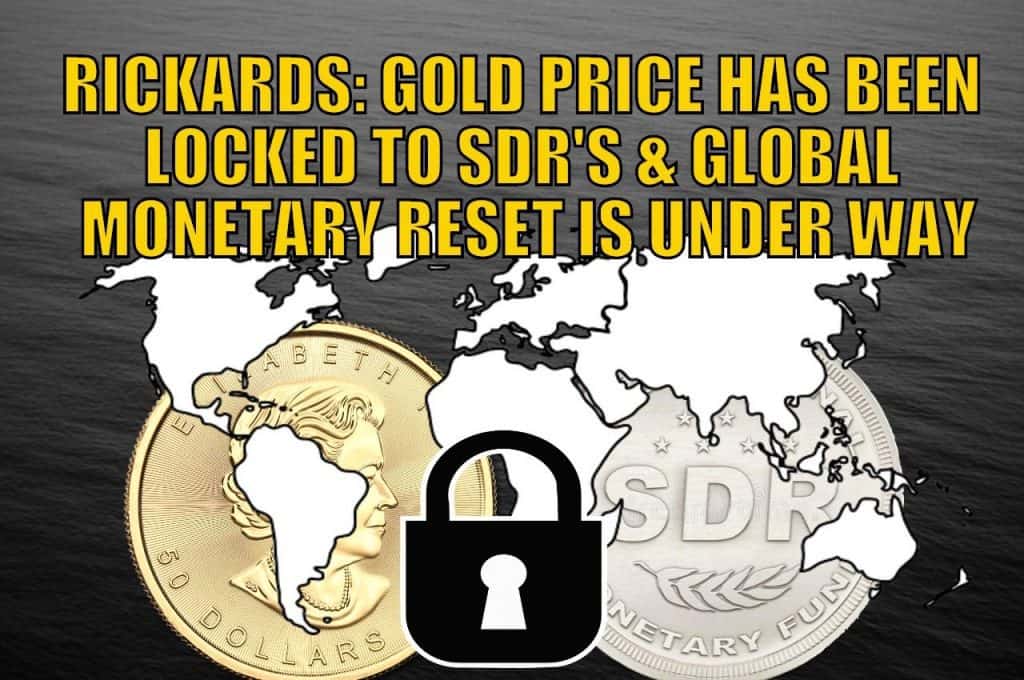GATA’s Chris Powell this week highlighted a reprint of an analysis by Jim Rickards in his latest Gold Speculator letter. Rickards argues:
“…that the great “global monetary reset” often speculated about is already underway, as indicated by the recent close correlation between the gold price and the International Monetary Fund’s super-currency, the Special Drawing Right, which began shortly after the IMF made the Chinese yuan a component of the basket of currencies composing the SDR. Since then, Rickards writes, the gold price, ordinarily volatile, has exhibited little volatility as priced in SDRs.
Rickards writes: “In short, world money has now been pegged to gold at a rate of SDR 900 to 1 ounce of gold. It’s a new gold standard using the IMF’s world money. There’s the global monetary reset right in front of your eyes.”
The charts contained in Rickards’ letter are not reproduced in GoldCore’s reprinting but they show the gold price measured in SDRs presenting a nearly horizontal line for the last year and a half.
Of course if the gold price and SDR valuation are now locked together, this doesn’t just mean that central banks are rigging the gold market. It means that every major central bank in the world is aware of and complicit in the rigging, likely preparing for another international currency revaluation, this time one in which gold is to be a major component, a revaluation that will change the value of all capital, labor, goods, and currency in the world.
This development evokes the paper written six years ago by the U.S. economists Paul Brodsky and Lee Quaintance, called to your attention by GATA, speculating the central banks were surreptitiously redistributing world gold reserves so that governments holding large foreign exchange balances in U.S. dollars could hedge themselves against a planned devaluation of the dollar:
http://www.gata.org/node/11373
Where is the public deliberation and democratic decision of such a momentous issue? Of course since this is modern central banking, there is to be none, and thus there is no democracy.
Where is the mainstream financial journalism pursuing this story? Of course there’s none of that either, though this dispatch will be distributed to many mainstream financial news organizations, organizations that long have been receiving and ignoring the documentation of central bank market rigging compiled by GATA over the years.
CHRIS POWELL, Secretary/Treasurer
Gold Anti-Trust Action Committee Inc.
It is an interesting theory and well worth the read. Whether it is true no one (but the select few) will know for sure. Perhaps the low volatility in gold is down to the complete apathy and lack of interest in the precious metals sector currently? But either way it likely makes now a good time to be getting some financial insurance.
Below is a chart from Goldchartsrus.com, via Dan Popescu on twitter showing gold expressed in SDR’s. Given the reprint doesn’t include the chart Rickards refers to, the below chart seems to be similar.

Here is the full text of Rickards’ letter as posted at GoldCore:
As The Currency Reset Begins – Get Gold As It Is “Where The Whole World Is Heading”
As the Reset Begins, Get Gold
by James Rickards for Agora Financial’s Gold Speculator
This may be the most important commentary I’ve ever written. Here’s why.
For years, financial analysts have discussed what’s called the Global Monetary Reset, or GMR. Expectations of a GMR stem from the fact that monetary policies around the world are unstable and unsustainable.

There is no anchor to the system. There is no limit on money printing. There is no limit on debt creation.
Such a system grows exponentially based on the false belief that governments can spend as much as they want and central banks will pick up the tab or bail out the system as needed.
Politicians love the system because they can buy votes from their citizens. Central bankers love the system because of the power and prestige it brings them. Citizens love the system because they get handouts, bailouts, pumped-up asset values and other goodies seemingly for free.
What’s not to like?
The problem, of course, is that the system is unstable and unsustainable. It’s a huge inverted pyramid of promises poised on a small sliver of real money called gold. It’s bound to tip over and come crashing down as it has many times in the past, from the Jubilees of ancient Israel to the global financial crisis of 2008.
The 2008 panic would have closed banks and capital markets globally but for tens of trillions of dollars of central bank intervention. That bailout money printing has still not been mopped up. The 2008 bailout has sown the seeds of the next crisis.
Viewing this broadly, an objective analyst can see that a new system based on some hybrid of dollars, gold and the IMF’s world money called special drawing rights (SDRs) is inevitable. This new system could even include an encrypted distributed ledger or blockchain, and might revert to fixed exchange rates instead of floating.
The GMR would be a return to something like the old Bretton Woods system (1944–1973) but with 21st-century characteristics and technology. This is what is meant by the Global Monetary Reset.
That much is clear. The open issues for students of the GMR are when it happens and how.
There are two answers to the how part. It can either happen in a proactive way by convening a new global monetary conference similar to Bretton Woods (1944), the Plaza Accord (1985) or the Louvre Accord (1987). Or it can happen in a chaotic fashion in response to a new financial crisis, as occurred at the G-20 Washington summit led by George Bush and Nicolas Sarközy in November 2008.
My estimate has always been that the GMR would be conducted in a panic due to the lack of leadership and foresight of the global monetary elites.
The answer to the when part is necessarily uncertain, but given what we know about the dynamics of complex systems and the scaling metrics of the current international monetary regime, the best answer is probably “soon.”
In a nutshell, a catastrophic collapse is coming, probably sooner than later, and the result will be an entirely new international monetary system in which the dollar is dethroned as the world’s leading reserve currency and something new is put in its place. That’s the GMR.
What if I told you the GMR already happened and no one noticed?
Here I have to acknowledge that some of the information that follows was provided to me by a source. The work of this source is tentative and requires more independent research. Yet it looks solid enough right now to share with readers.
I’ll be writing more about this revelation in my new book, Aftermath, coming Oct. 30, 2018. You can preorder a copy here.
In Aftermath, I’ll disclose more about the origin of this information.
For now, I just want to be fair and acknowledge that it originated with an unsolicited research report sent to me from a correspondent named D. H. Bauer based in Switzerland. We’ll call him “DHB” for now.
Let’s start with a simple analysis we’ve all done ourselves and expand that analysis with information from DHB. Then I’ll provide some conclusions that stem from this presentation.
We all follow the price of gold. We think of gold as about $1,320 per ounce. We say it is “up” or “down” by $10 per ounce and so on. When we do this, we are really quoting a cross-rate between U.S. dollars (USD) and one ounce of gold (GOLD).
Let’s call this cross-rate USD/GLD.
We also follow the cross-rate between the U.S. dollar and the Chinese yuan (CNY). That’s the exchange rate between the currencies of the two largest economies in the world, which combine to produce almost 40% of global GDP.
When China instituted a shock devaluation of their currency in August 2015, U.S. stock markets fell 11% in three weeks and it looked like there was no bottom. Then the Fed intervened with a delay of the liftoff in rate hikes from September–December 2015.
China devalued again in December 2015, and U.S. stocks fell 11% again from Jan. 1 to Feb. 10, 2016. It took the G-20 Shanghai Accord in late February 2016 to put an end to Chinese shock devaluations. This recent history reveals that the U.S.-China cross-rate is one of the most important metrics in world finance.
Let’s call this cross-rate USD/CNY.
Finally, if you’re a geek like me, you take a look at the U.S. dollar value of the SDR every day. It’s not a secret; the IMF actually publishes that cross-rate daily, found here. As of this writing, SDR1 = USD1.419, but that rate changes daily like any floating exchange rate.
Let’s call this cross-rate SDR/USD.
Now, you all recall the transitive law from middle-school math. In short form it says:
If A = B and
B = C, then
A = C.
In other words, if you have two equalities, you can substitute a factor from one for a factor from another and still end up with an equality.
Here’s where DHB’s insight comes in.
He took the known quantities of USD/GLD and SDR/USD and applied the transitive law to calculate SDR/GLD.
While I think about USD/GLD, USD/CNY and SDR/USD all the time, I have to admit I never thought much about SDR/GLD.
Why would I? I don’t own any SDRs and I can’t get my hands on any. The IMF only issues them to member countries, and they’re traded among the members through a secret trading desk inside the IMF.
If I want to buy gold, I use dollars. In China, they can buy gold with yuan. The idea of buying gold with SDRs may be off in the future, but there’s no active gold market priced in SDRs today.
Or is there?
DHB took a look. What he found was shocking. It’s summarized in this chart:
Source: D. H. Bauer
The timeline along the horizontal x-axis runs from Dec. 31, 2014 to March 31, 2018. The price line along the vertical y-axis is measured in units of dollars or SDRs depending on the data series. The units run from 700–1,400.
The red line is the dollar price per gold ounce (USD/GLD). The dark-blue line is the USD/GLD trend. The green line is the price per ounce of gold in SDRs (SDR/GLD). The purple line is the SDR/GLD trend.
The black vertical line indicates the date, Oct. 1, 2016, that the IMF allowed the Chinese yuan to join the “basket” used to determine the value of an SDR. (The rest of the basket consists of dollars, pounds sterling, euros and Japanese yen.)
Here’s what DHB discovered. Before China joined the SDR, both the dollar price of gold and the SDR price of gold were volatile. After China joined the SDR, the dollar price of gold continued to be volatile, but the SDR price of gold exhibited much less volatility, especially after the first few months.
Related: China Joins the SDR Old Boys Club. What’s the Significance?
Most importantly, the trend line of SDR/GLD is a near-perfect horizontal line.
In short, world money has now been pegged to gold at a rate of SDR900 = 1 ounce of gold. It’s a new gold standard using the IMF’s world money.
There’s the GMR right in front of your eyes.
It takes a while to sink in. Why did SDR/GLD go from normal volatility to no volatility overnight? The straight-line behavior of SDR/GLD after the Chinese yuan joined the SDR is impossible without some kind of intervention or manipulation. The odds of this happening randomly are infinitesimal.
The SDR/GLD horizontal trend line after Oct. 1, 2016, is an example of what statisticians call autoregression. This only appears if there’s a recursive function (a “feedback loop”) or manipulation or if it’s presented as a fraud. This is how Harry Markopolos spotted the Bernie Madoff fraud; Madoff’s returns were too steady and consistent to be real given the volatile nature of capital markets.
In the case of SDR/GLD, we can rule out a recursive function because gold trades in a relatively free market determined by supply and demand. We can rule out randomness (statistically impossible) and fraud (the data come from public sources; no one is making them up). That leaves manipulation as the only possible explanation.
How would you conduct such a manipulation, and who’s behind it?
To peg a cross-rate, in this case SDR/GLD, you need a large floating supply of both components or a printing press to make as much as you need. Basically you conduct open market operations.
If the SDR price of gold rises above SDR900, you sell gold and buy SDRs (or the currency basket). If the SDR price of gold sinks below SDR900, you buy gold and sell SDRs (or the currency basket). By monitoring markets and intervening continually with open market operations in gold and currencies, you can maintain the peg.
There are only four parties in the world who could conduct such a manipulation: the U.S. Treasury, the ECB, the Chinese State Administration of Foreign Exchange (SAFE) and the IMF itself. These are the only entities with enough gold and SDRs to be able to conduct the open market operations needed to peg the price.
We can eliminate the U.S. Treasury and ECB as suspects. That’s because they are relatively transparent about their total gold holdings, foreign exchange reserves and the SDR component of their reserves. (For the ECB we look at the large members such as Germany and France for the data.) If either one were conducting open market operations, there would be fluctuations in holdings of gold and SDR component currencies that would appear in official reports. No such fluctuations appear, so they’re off the list.
That leaves SAFE and the IMF. Both are nontransparent. China has about 2,000 tons of gold (probably much more, but they don’t disclose the excess) and has been acquiring SDRs in secondary market trading in addition to official allocations to IMF members.
The IMF has about 1,000 tons of gold and can print all the SDRs it wants with its SDR printing press. The IMF also makes loans and receives principal and interest in SDRs. The SDRs can be traded through the IMF’s secret trading desk.
Even now, the IMF is preparing to bail out Argentina. When that happens, the IMF loans will be in SDRs. Argentina needs dollars to defend its currency, so they’ll have to swap their new SDRs for dollars. China will be a willing swap counterparty through the IMF’s secret trading desk.
That’s how China acquires more SDRs than its IMF allocation permits. Those “extra” SDRs are crucial to China’s ability to conduct open market operations in gold and SDRs.
The gold can be traded secretly through the Bank for International Settlements (BIS), which traded Nazi gold in the Second World War. The BIS is super-secret and is controlled by the same people who control the IMF.
China can also conduct gold purchases and sales for yuan or dollars on the open market in Shanghai and London and separately buy or sell SDRs for dollars or yuan. China can also buy or sell the SDR basket currencies separately as a synthetic SDR to manipulate the price of the actual SDR.
This kind of intervention by China to maintain the SDR/GLD peg might also explain the mysterious “gold slams” we see in Comex gold futures trading with regularity.
Analysts have speculated for years that China was acquiring gold in anticipation of a new gold-backed yuan. I always disputed that idea because China does not have a good rule of law. The yuan lacks the kind of deep liquid bond markets, primary dealers, repo facilities, futures contracts and other legal infrastructure needed to be a major reserve currency with or without gold backing. The yuan is a decade or more from becoming a major reserve currency
But the SDR is an ideal vehicle for a gold-backed currency because it has the support of every major economic power on Earth through the IMF.
The bottom line is that China has now pegged the SDR to gold. This is highly ironic, because when the SDR was created in 1969 it was originally pegged to gold and defined as a weight in gold (SDR1 = 0.88867 grams of gold). That peg was abandoned soon after, even as the dollar peg (USD1 = 1/35th ounce of gold) was also abandoned.
Since this SDR peg to gold is informal, it can be abandoned at any time. It probably will be abandoned because the Chinese sponsors of the peg have ignored the lessons of 1925 when the U.K. returned sterling to the gold standard at the wrong price. The result was catastrophic deflation that presaged the Great Depression.
The Chinese peg of SDR900 is far too cheap to be sustainable given the scarce supply of gold and the growing supply of SDRs. More to the point, the IMF will print trillions of SDRs in the next global financial crisis, which will prove highly inflationary.
Still, this is a historic development, and we’ll be watching it closely inRickards’ Gold Speculator. Even if the peg is unsustainable in the long run, it’s a clear short-run signal that China is betting on the SDR and gold, not the yuan or the dollar.
My advice under these circumstances is simple. Dump dollars, yuan and SDRs (if you have any) and get gold.
That’s where the whole world is heading.
Read more on this topic: Does a Gold Revaluation to US$10,000 With All Major Countries Make Sense?
All the best,
Jim Rickards
Editor, Rickards Gold Speculator


Pingback: If the US Dollar or SDR Was Linked to Gold, How Would This Affect New Zealand? - Gold Survival Guide
Pingback: How Will the Global Monetary System Change Take Place? Will China Take over the Reserve Currency Role? - Gold Survival Guide